Municipality aims to become world-class, tech-savvy hub
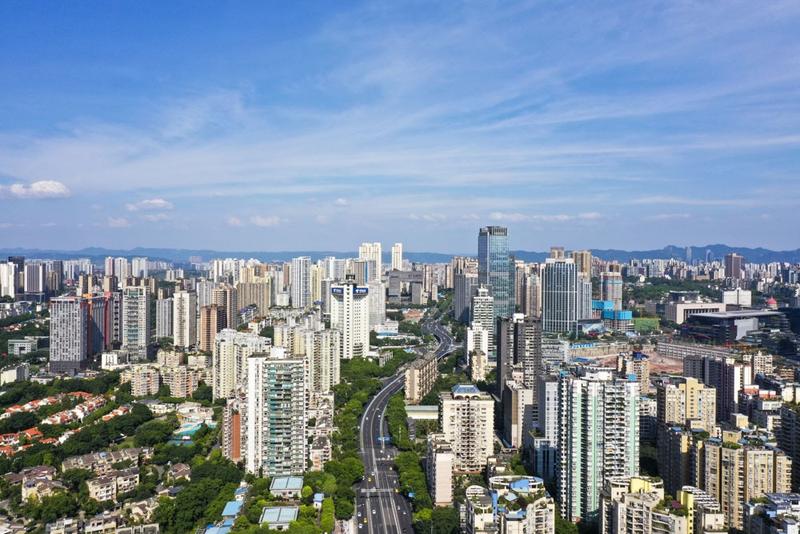 Liangjiang New Area in Chongqing is the third State-level economic development zone in China. (LIU CHAN / XINHUA)
Liangjiang New Area in Chongqing is the third State-level economic development zone in China. (LIU CHAN / XINHUA)
In 2019, when Han Daguang, co-director of a research institute at the University of Leuven in Belgium, moved his family of four to Chongqing, his friends were surprised by the decision.
Overseas Chinese used to choose cities in coastal areas when they relocated to the country, but that has changed.
The research institute that employed Han in Chongqing's Liangjiang New Area, the nation's first inland economic development zone, received a flurry of 40 resumes in just one week from Chinese students living abroad, 20 percent of whom hold doctorates from top overseas universities.
Han, 39, who was born in Northeast China, said he chose Chongqing for its preferential policies, competitive salaries and subsidies, sound working environment, advanced education facilities and the vision and determination of the local government to drive technological innovation.
The rags-to-riches transformation of Liangjiang New Area has fueled the arrival of a flood of new talent. It is the country's third State-level economic development zone, after Pudong New Area in Shanghai and Binhai New Area in Tianjin, and aims to help build Chongqing into a world-class, tech-savvy city.
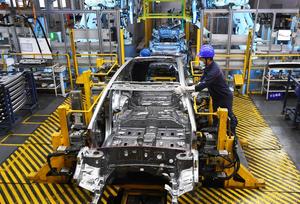 Workers assemble vehicles at Changan Automobile Co in Chongqing. (WANG QUANCHAO / XINHUA)
Workers assemble vehicles at Changan Automobile Co in Chongqing. (WANG QUANCHAO / XINHUA)
Located where the Yangtze and Jialing rivers converge, the site used for the new area was occupied 10 years ago by numerous hillside homes and large areas of farmland. Now, gleaming skyscrapers shed light on the rivers day and night.
The 1,200-square-kilometer area, which occupies 1.5 percent of the land in Chongqing, produces 15 percent of the city's economic output and has become a key driver for such growth.
The area's transformation is also part of a broader effort by the Chongqing government to drive the development of inland cities.
As a mountainous metropolis on the upper reaches of the Yangtze, Chongqing is particularly well suited to play its role as a gateway to western regions.
The city boasts a large river port, international airport and a network connecting railways, waterways and roads in countries taking part in the Belt and Road Initiative. This has helped the city become an international trade and logistics hub linking China, Europe and other parts of Asia.
Last month's annual tone-setting Central Economic Work Conference highlighted the role of regional development and efforts to promote high-quality coordinated expansion at this level.
At the conference, it was agreed to advance technological innovation by attracting high-level talent to solve major problems restricting the nation's economic development.
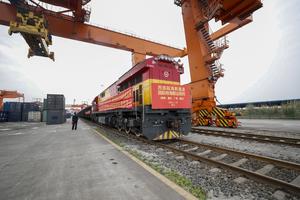 A freight train from Qinghai province in West China stops in Chongqing en route to Qinzhou, Guangxi Zhuang autonomous region, in the southwest of the country. (HUANG WEI / XINHUA)
A freight train from Qinghai province in West China stops in Chongqing en route to Qinzhou, Guangxi Zhuang autonomous region, in the southwest of the country. (HUANG WEI / XINHUA)
Deeper integration
Chen Min'er, Chongqing's Party chief, said, "In coming years, the city will deepen its integration with the BRI and construction of the New International Land-Sea Trade Corridor to speed up the building of a highland area for opening-up."
The new corridor, a trade and logistics route, was jointly launched by western provinces and regions in China and by Singapore as part of the China-Singapore (Chongqing) Demonstration Initiative on Strategic Connectivity, or Chongqing Connectivity Initiative.
In the first half of last year, nearly 390 land-sea international trips were made along the route, with 1,966 journeys completed since the official opening in September 2017 to June last year.
"Chongqing will also promote construction of the Chengdu-Chongqing economic cycle and take the opportunity to build the city (Chongqing) into an important economic center with national influence, a scientific and technological innovation center, a new highland area for reform and opening-up, and a high-quality place to live," Chen said.
The Chengdu-Chongqing economic cycle, proposed at a meeting of the Political Bureau of the Communist Party of China Central Committee in October, aims to make the municipality and Chengdu, capital of Sichuan province, western China's new growth engines.
Bai Ming, deputy director of the Academy of International Trade and Economic Cooperation at the Ministry of Commerce, said: "Compared with other economic super-regions, like Beijing-Tianjin-Hebei, the Yangtze River Delta and the Guangdong-Hong Kong-Macao Greater Bay Area, the Chengdu-Chongqing economic cycle's advantages lie not in size or scale, but in industrial diversity. It will greatly improve equality in regional development and promote structural change."
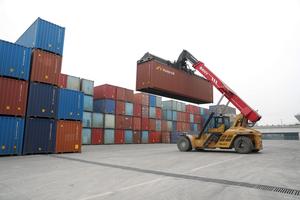 Workers load freight at the New International Land-Sea Trade Corridor container center in Chongqing. (HUANG WEI / XIINHUA)
Workers load freight at the New International Land-Sea Trade Corridor container center in Chongqing. (HUANG WEI / XIINHUA)
Huang Chaoyong, under-secretary-general of the CPC Chongqing Municipal Committee, said the aim is for Liangjiang New Area to become "a smart hub for Chongqing and an open gateway to inland regions", and also "a high-quality development area and high-quality living space".
"More efforts will be made to build a modern industrial cluster to drive high-end, high-quality and high-tech industries and to raise the level of openness to accommodate global high-end resources," said Huang, quoting a new guideline published by the local government on Friday.
He said that by 2025, innovation and entrepreneurship will be fully stimulated, the area will lead western regions with its openness, and the level of intelligent governance will be significantly improved. In particular, a number of modern industrial clusters with influence at national level will be formed and the area's GDP will exceed 500 billion yuan (US$72 billion) by that year, he added.
To drive new growth engines, Liangjiang New Area has been preparing to develop scientific innovation and to accelerate strategic industries, including the digital economy, intelligent manufacturing and new materials.
The Philippine Associated Smelting and Refining Corp, or Pasar, a leading copper smelter from the island nation, is one of the foreign companies to benefit from digitalization in the new area.
When the company faced a severe shortage of supplies due to the pandemic, CD Industry Inc, an industrial internet platform in Liangjiang New Area, helped it find supply chain components.
An official from Pasar said, "Without this help, we would have had to set up a huge procurement team to connect with all the Chinese suppliers, more than 60 percent of which still don't have a comprehensive and unified overseas sales system."
Yu Yao, chairman of CD Industry Inc, said foreign customers often face problems such as high procurement costs and a shortage of information, while domestic manufacturers lack export skills. This situation has worsened during the pandemic.
"By using big data, we help overseas buyers connect with high-quality industrial enterprises in China, and at the same time promote the country's manufacturing companies to overseas markets," Yu said.
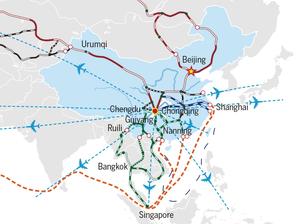 Chongqing, an international hub in inland China, is promoting its air, land and sea logistics routes. (PHOTO / CHINA DAILY)
Chongqing, an international hub in inland China, is promoting its air, land and sea logistics routes. (PHOTO / CHINA DAILY)
Suppliers located
More than 35,000 small and medium-sized manufacturing enterprises from China have been connected to CD Industry Inc's platform, which has also enabled over 5,000 overseas companies involved in the Belt and Road Initiative to find suppliers in China.
Data from the Chongqing Liangjiang New Area Administrative Committee show that strategic emerging industries account for more than 59 percent of the area's industrial output.
In the first 11 months of last year, the output of electronics companies in the area reached 165.6 billion yuan, a year-on-year rise of 13.6 percent.
In addition to developing new industries, the area is advancing traditional ones such as the automobile sector. Chongqing is now one of the country's leading centers for car manufacturing, attracting global brands such as Hyundai, Iveco, General Motors and Ford.
A 5G intelligent heavy-duty truck produced by SAIC Hongyan, an automobile manufacturer headquartered in Liangjiang New Area, debuted recently at Shanghai Yangshan Port. The truck, which can collect and analyze data and upgrade it automatically, has helped the facility become one of the world's first smart ports with 5G technology.
Despite the challenges brought by the pandemic, the company exported 64 heavy-duty trucks to Turkmenistan late last year. The vehicles have been customized to cope with rugged terrain in the Central Asian nation.
Lou Jianping, president of SAIC Hongyan, said: "The company will continue to increase exports to the Central Asian market. Exporting vehicles to Turkmenistan has expanded our overseas presence.
"As part of the BRI, we will continue to beef up our efforts in going abroad and actively exploring overseas markets."
In the first three quarters of last year, the automaker shipped about 1,000 trucks to countries and regions involved in the BRI, including Cambodia, Vietnam and the Democratic Republic of Congo. For three years running, it has topped the market share in China for this type of vehicle.
Lou added: "Last year, our export business saw 50 percent year-on-year growth. This year, it is set to witness further explosive expansion."
Contact the writers at chengyu@chinadaily.com.cn


